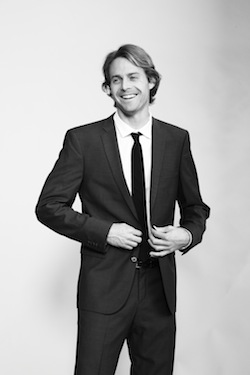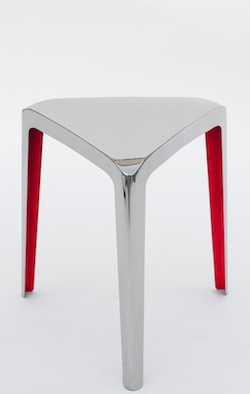
Chris Adamick
Chris Adamick (BA 07 Environmental Design) is the manager of Global Marketing, Store Design at Gap’s New York headquarters. He is an award-winning designer whose multidisciplinary, large- and small-scale work includes commercial, civic, educational and residential design. Adamick maintains his own studio, Chris Adamick Design, for independent projects, and has collaborated with Bernhardt Design, among others. Bernhardt honored Adamick in 2011 by featuring his Audio chair in a retrospective at ICFF of its ongoing interdisciplinary studio with Art Center College of Design, which educates students in the process of designing products for production in the commercial market. Today Adamick’s client list includes Bed Bath and Beyond, W Hotels, Disney and Haworth and he has held prominent positions at Pentagram, Rios Clementi Hale Studios, ByLissoni, Studio Gaia and other high-profile companies.
The Dotted Line: What drew you to Art Center?
Chris Adamick: Jorge Pardo [the noted sculptor and an Art Center graduate], one of my professors at UCLA, opened my mind to art existing in the world beyond fine art—in architecture, in product design. He suggested Art Center. I looked at the Fine Art program first and it was stellar, just stellar, but when I saw the design work going on there [at the College], I instantly knew that was what I wanted to do.
TDL: How did your exposure to faculty artists and fellow students inspire you?
CA: That was huge. It’s like the single greatest thing about the school, with all these talented people from different backgrounds exploring different avenues. I had friends in photography, in film, in fine art, so I took all of these classes. The faculty was insanely awesome. Frank Clementi served as a mentor to me. David Mocarski, James Meraz, Gloria Fowler and Rob Ball matched my enthusiasm and commitment. [The late] Mike Kelley let me crash his course. He was so smart and intense in such a great way. I could just go on and on.
I got to experience so much. In terms of growing my mind and appetite for design, art and culture it couldn’t get any better. I loved it.
TDL: What did you learn at Art Center that has most benefited you as an artist?
CA: Art Center says you have to work harder than other people, because you’re often presenting new ideas and it’s incumbent upon you to present that in the most professional way, especially if your ideas are challenging and outside their world view. That was a huge lesson and it couldn’t be more helpful to me now.
![Chris Adamick's Audio Chair, Bernhardt Design [the red chair]](http://blogs.artcenter.edu/dottedline/wp-content/uploads/2014/05/BernhardtDesign_Audio-e1400255659540.jpeg)
Chris Adamick’s Audio Chair for Bernhardt Design
CA: It develops daily. I try and cultivate the most creative group of people around me I can and keep myself excited by new ideas. I question my reality and try and apply that to the real world problems I’m given. I don’t come at it like, here’s my blanket solution. To me that’s not so useful.
I think about myself, when I was seven. As soon as I knew you had to have a job, I said, okay, I’m going to be an artist. I think about whether that seven-year-old would be excited about what I’m doing and would be proud of it. That’s the test. Does seven-year-old Chris care about designing things for rich people? Well, sometimes, but if it’s just creating some sort of bling, no, seven-year-old Chris does not care.
TDL: I understand your 2012 Copper Table was inspired partly by your visit to photographer Julius Shulman’s Hollywood home.
CA: That’s a good example of happenstance. Julius Shulman is brilliant. I was so thrilled that I got to go to his home. It was filled with Eames prototypes under stacks of books signed by Modernists. He had all of these original pieces by artists and architects in use over time. It was such a rich environment, the opposite of how modernism is presented in magazines. That was something that sparked in my mind: that you can do modernism in a way that’s lived in and comfortable. It was the first time it hit me in a personal way.
My fiancée is a nurse and we talk a lot about the things people need to be healthy and happy in a hospital environment. Anything can be an inspiration. It can come from everything.
TDL: You are LEED [Leadership in Energy and Environmental Design] accredited. Is green design fundamental to what you do?
CA: It’s so fundamental it should be part of the design process without having to state it. If you’re designing something purpose-built, that component has to be there. If it’s not there, the design is flawed. Unfortunately, clients often feel that it will be a more costly endeavor to add into a brief. Some enlightened people do put it in. Otherwise, you just do it anyway. It’s just a matter of being respectful of the world, which the design should be.
TDL: You’ve held high-level positions at prominent companies and you also continue to create work in your own name. How do you manage that?

Chris Adamick’s Clic Stool for Arktura
CA: I don’t sleep very much. [He laughs.] My career is very demanding and I travel a lot, but when things come along and there’s a tasty design brief that I want to do, I take it on and throw everything at it. And usually that experience will inform something later in my career or I learn something from it.
I think it just has to do with your commitment level to creative endeavor in general. If you have this appetite to do it, Art Center will help you because it gives you the tools you need to do things on your own and for clients and to handle that all at once.
TDL: How can students coming into Environmental Design make the most of the program?
CA: Because it’s a school, you might say, okay, these people are going to focus on product design and those people are going to be photographers. But who says photography and product design don’t intersect? In fact they do—every single day in my pocket on my iPhone. You have to understand the world in a broader context if you want to be a successful designer, or if you want to do interesting work at least. I think it’s foolish to think that you don’t have to identify the boundaries of what you yourself practice, but it’s also foolish to think it stops at those boundaries.
Lynne Heffley is a Los Angeles-based freelance journalist who writes about the arts.








